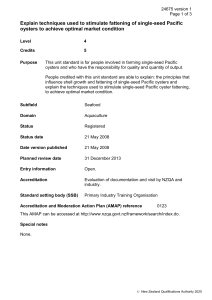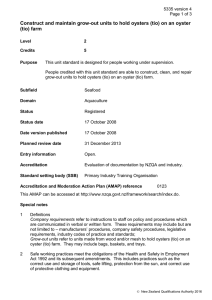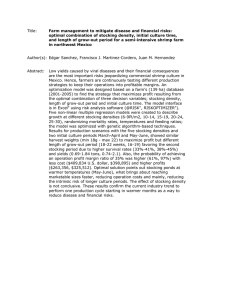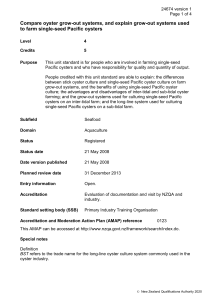Explain techniques used for farming single-seed Pacific oysters to
advertisement
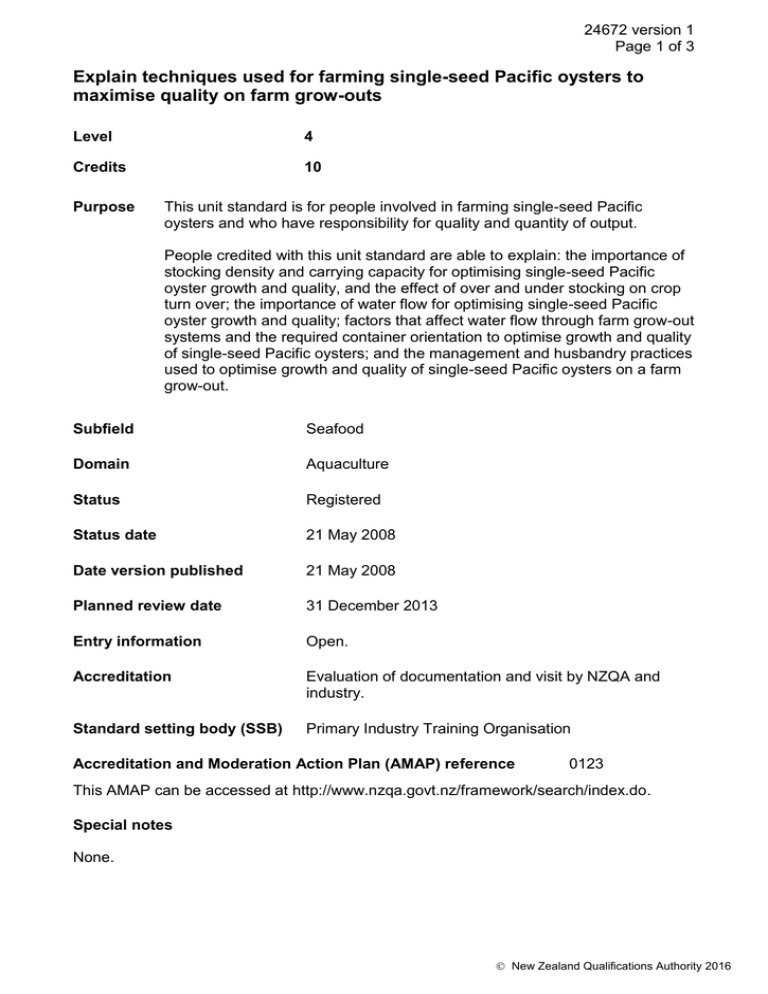
24672 version 1 Page 1 of 3 Explain techniques used for farming single-seed Pacific oysters to maximise quality on farm grow-outs Level 4 Credits 10 Purpose This unit standard is for people involved in farming single-seed Pacific oysters and who have responsibility for quality and quantity of output. People credited with this unit standard are able to explain: the importance of stocking density and carrying capacity for optimising single-seed Pacific oyster growth and quality, and the effect of over and under stocking on crop turn over; the importance of water flow for optimising single-seed Pacific oyster growth and quality; factors that affect water flow through farm grow-out systems and the required container orientation to optimise growth and quality of single-seed Pacific oysters; and the management and husbandry practices used to optimise growth and quality of single-seed Pacific oysters on a farm grow-out. Subfield Seafood Domain Aquaculture Status Registered Status date 21 May 2008 Date version published 21 May 2008 Planned review date 31 December 2013 Entry information Open. Accreditation Evaluation of documentation and visit by NZQA and industry. Standard setting body (SSB) Primary Industry Training Organisation Accreditation and Moderation Action Plan (AMAP) reference 0123 This AMAP can be accessed at http://www.nzqa.govt.nz/framework/search/index.do. Special notes None. New Zealand Qualifications Authority 2016 24672 version 1 Page 2 of 3 Elements and performance criteria Element 1 Explain the importance of stocking density and carrying capacity for optimising single-seed Pacific oyster growth and quality, and the effect of over and under stocking on crop turn over. Performance criteria 1.1 The explanation includes the importance of stocking density and carrying capacity in the farm grow-out system to achieve optimum growth and quality of single-seed Pacific oysters. 1.2 The explanation includes the effects of over and under stocking on single-seed Pacific oyster crop turn over on farm grow outs. Element 2 Explain the importance of water flow for optimising single-seed Pacific oyster growth and quality. Performance criteria 2.1 The explanation includes the importance of water flow through the farm growout system to achieve optimum growth and quality of single-seed Pacific oysters. Element 3 Explain factors that affect water flow through farm grow-out systems and the required container orientation to optimise growth and quality of single-seed Pacific oysters. Performance criteria 3.1 The explanation includes factors that affect water flow through farm grow-out systems and the required container orientation to optimise the growth and quality of single-seed Pacific oysters. Range evidence of six factors is required. Element 4 Explain the management and husbandry practices used to optimise growth and quality of single-seed Pacific oysters on a farm grow-out. Performance criteria 4.1 The explanation includes the management practices required to optimise the performance of single-seed Pacific oysters on the farm grow-out. New Zealand Qualifications Authority 2016 24672 version 1 Page 3 of 3 4.2 The explanation includes the husbandry practices used to optimise the performance of single-seed Pacific oysters on a farm grow-out. Range may include but is not limited to – handling, stocking density, placement of containers, mesh size, height control, rumbling, out of water time. evidence of four is required. Please note Providers must be accredited by the Qualifications Authority, or an inter-institutional body with delegated authority for quality assurance, before they can report credits from assessment against unit standards or deliver courses of study leading to that assessment. Industry Training Organisations must be accredited by the Qualifications Authority before they can register credits from assessment against unit standards. Accredited providers and Industry Training Organisations assessing against unit standards must engage with the moderation system that applies to those standards. Accreditation requirements and an outline of the moderation system that applies to this standard are outlined in the Accreditation and Moderation Action Plan (AMAP). The AMAP also includes useful information about special requirements for organisations wishing to develop education and training programmes, such as minimum qualifications for tutors and assessors, and special resource requirements. Please note Providers must be accredited by NZQA, or an inter-institutional body with delegated authority for quality assurance, before they can report credits from assessment against unit standards or deliver courses of study leading to that assessment. Industry Training Organisations must be accredited by NZQA before they can register credits from assessment against unit standards. Accredited providers and Industry Training Organisations assessing against unit standards must engage with the moderation system that applies to those standards. Accreditation requirements and an outline of the moderation system that applies to this standard are outlined in the Accreditation and Moderation Action Plan (AMAP). The AMAP also includes useful information about special requirements for organisations wishing to develop education and training programmes, such as minimum qualifications for tutors and assessors, and special resource requirements. Comments on this unit standard Please contact the Primary Industry Training Organisation standards@primaryito.ac.nz if you wish to suggest changes to the content of this unit standard. New Zealand Qualifications Authority 2016
